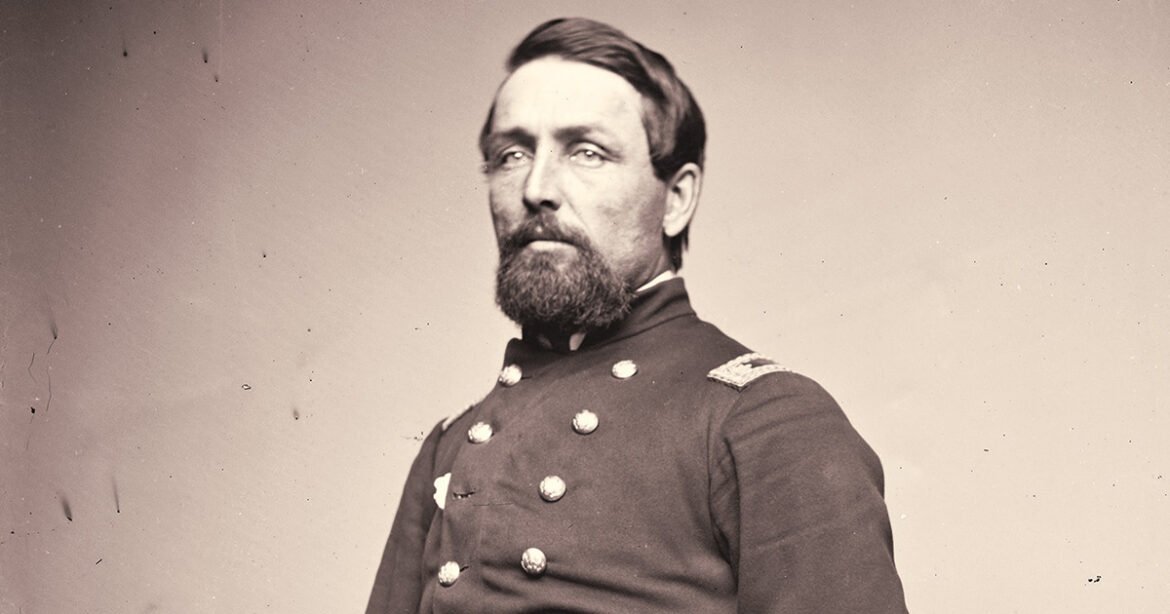Tour Stop One at Vicksburg National Military Park is the location of “Battery DeGolyer.” Named after its commanding officer, Captain Samuel DeGolyer, the position had the heaviest concentration of guns on the Union lines during the 47-day Siege of Vicksburg—22 in all.
Though four times the size of a standard Union battery, the position consisted of the 8th Battery Michigan Light Artillery; Yost’s Independent Ohio Battery; Company L, 2nd Illinois Light Artillery; and the 3rd Battery Ohio Light Artillery. Throughout the Siege of Vicksburg, each gun fired two shots an hour daily and, on average, during the siege. The arrangement fired a total of 2,409 projectiles at the Confederate Great Redoubt. But a quick look around Tour Stop One does not indicate who Captain Samuel DeGolyer was, nor does it mention his remarkable performance during the campaign for Vicksburg.
Who was Sam DeGolyer? Born in upstate New York in 1827, young Sam and his family (pronounced De-Goy-er), moved to Michigan in the 1830s and settled around the Hudson area in the southeastern part of the state. DeGolyer married Catherine Jeffers of Lenawee County and in 1854 their daughter Kate was born. As a young man in Hudson, he was very active in the small farming community and his stout stature and piercing gaze reflected a determined man of action. DeGolyer also held various public posts and positions, owned a spoke-and-wheel production operation, and when war broke out in April 1861, used his popularity with the community to put together a company of volunteers to put down the rebellion.
Company F, “Hudson Volunteers,” with Captain Samuel DeGolyer in command, was mustered in as the 4th Michigan Volunteer Infantry on June 20, 1861. A month later, DeGolyer and his men eagerly waited on the plains of Manassas, Va., for their turn to get at the “secesh.”
The First Battle of Bull Run on July 21 was a strange sight. The movement of units on the battlefield was sophomoric at best. Regiments on both sides attempted to flank one another using parade-ground maneuvers, but with the air clogged with lead and metal and, moreover, inconsistencies between weapons, flags, uniforms (the 4th Michigan was dressed in gray) and orders, the efforts to break each line often resulted in a bloody repulse.
Some units even ran into each other or fired into the backs of their comrades. Many soldiers, stripped to the waist, passed out from paralyzing fear or heat exhaustion. Fortunately, as the green 4th Michigan waited its turn to deploy into the fray, the men probably could not see much. Smoke blocked their view, but what was going on beyond it favored the Union Army. News from aides dashing all over the field projected victory, yet the tide changed as Confederate forces received reinforcements just at the right time. Thomas J. Jackson’s Virginia soldiers and J.E.B Stuart’s cavalry plowed into the exhausted Union lines and scattered the raw citizen-soldiers in every direction.
Through the thick smoke, the 4th Michigan could hear the shrieks of horrified Union soldiers blended with the yells of oncoming Confederates. Suddenly, groups of panicked federals burst out of the smoke clouds and slammed into the Michiganders’ ranks. A melee erupted and, while searching for a better glimpse of the fight, Southern soldiers captured DeGolyer and sent him off to Richmond. Following the Union disaster at Bull Run, and after hearing of his capture, DeGolyer’s hometown newspaper, The Hudson Gazette, asserted that “the fact is, Sam was spoiling for a fight and he wasn’t born to be shot.” But for a personality such as DeGolyer’s, such a prophecy was bound to be tested.
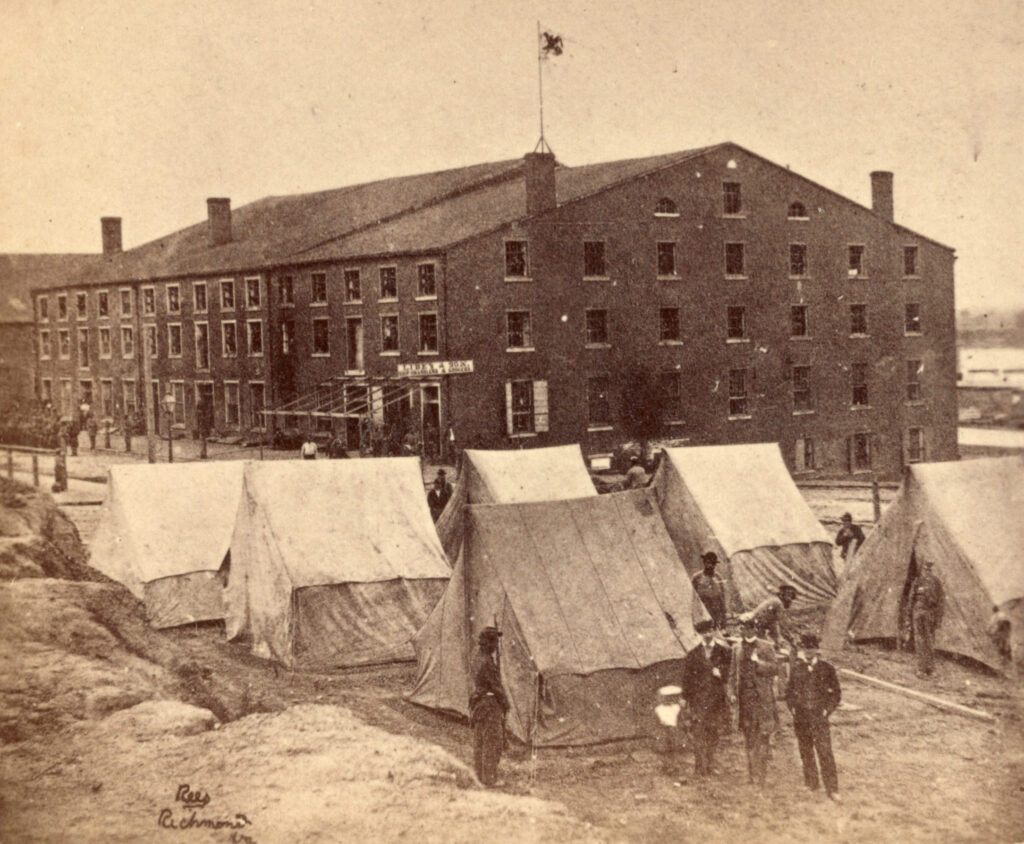
(Library of Congress)
On August 13, 1861, Sam DeGolyer escaped Richmond’s Libby Prison, and for a week, DeGolyer and a companion navigated through the swampy Virginia labyrinths, dodging patrols and dueling armies along the way. Eventually, they made it to the safety of a tobacco vessel headed to Baltimore. Weeks later, DeGolyer met with President Abraham Lincoln and General Winfield Scott. Both made sure to acknowledge publicly the heroic escape from deep within the enemy territory (a much-needed story of redemption for a nation reeling following its embarrassing showing at First Bull Run). With public adulation and inflation of ego, DeGolyer headed back to Michigan. He immediately went to work recruiting 100 men for the 4th Michigan and was promoted to major of the regiment upon his return.
Colonel Dwight A. Woodbury, however, was annoyed with DeGolyer’s promotion. Woodbury, a phlegmatic leader who looked and acted every-part of a regimental commander, thought DeGolyer habitually hasty in his actions, especially following his delinquent escapades at Bull Run and thus judged him a scoundrel and a rogue—indifferent to orders. So, in the winter of 1861 and on a short leash, Major Sam DeGolyer set out on his daily duties as third in command of the 4th Michigan Infantry. It did not last long.
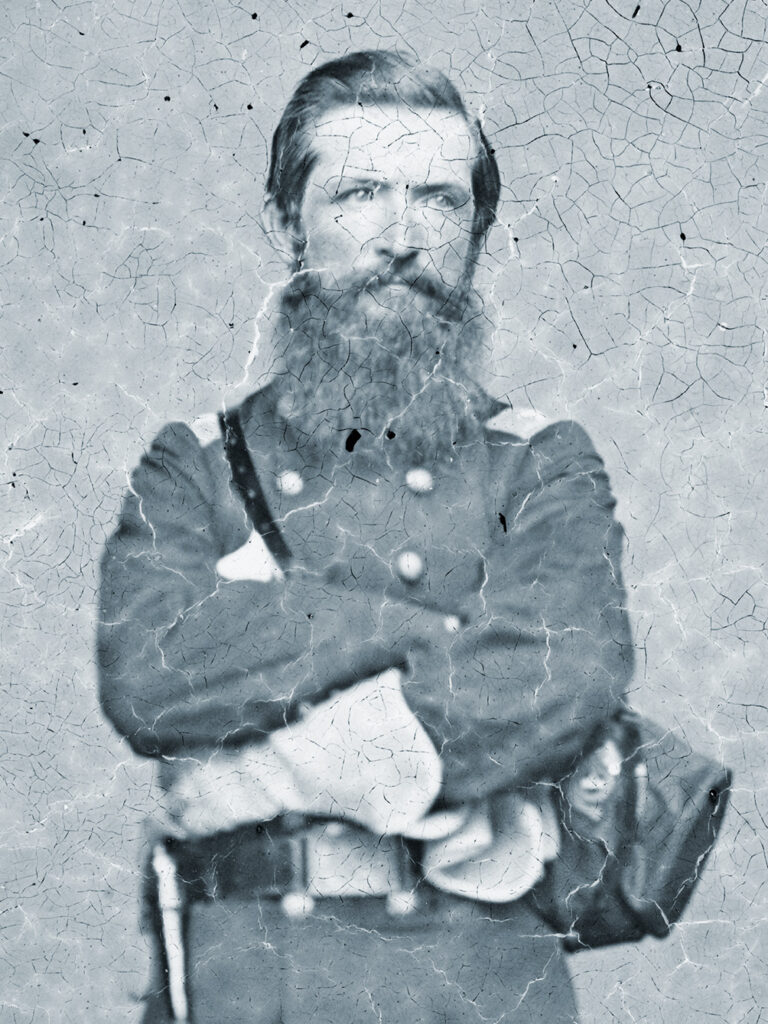
(Library of Congress)
In December 1861, while bivouacked outside Washington D.C., Colonel Woodbury learned that DeGolyer ordered the home of some defiant Confederate sympathizers to be stripped of all windows and doors. Woodbury wasted no time in cashiering DeGolyer and sent him back to Michigan to await further orders. Fortunately for DeGolyer, he escaped the “Old Fourth”—the regiment evidently had an officer curse. Four colonels were eventually killed in action, including Woodbury, and Dexter, Mich., native Harrison Jeffords, the highest commissioned officer killed by a bayonet during the Civil War.
DeGolyer returned to Michigan and soon was at work with a new plan: raise an artillery battery. But not just any battery, a ‘flying battery.’ Napoleon used such instruments of war successfully on the battlefield, and so would DeGolyer. Battery H, 1st Michigan Light Artillery (aka the 8th Michigan Light Artillery) was mustered into service on March 6, 1862, in Monroe. The battery consisted of six guns: two 12-pounder howitzers and four 12-pounder James Rifles. These guns were not particularly powerful but were able to quickly discharge rapid salvos while maneuvering around the battlefield with speed. And with that, the 1st Michigan Light Artillery headed to the war’s Western Theater.
On May 1, 1863, after months of failed probes at the defenses of Vicksburg, Maj. Gen. Ulysses S. Grant and his approximately 70,000 men landed below the bastion on open terrain. His goal: cut off Vicksburg from the supply lines at Jackson, Miss., and coax the Confederates under Lt. Gen. John Pemberton out from their defenses and destroy them in detail. DeGolyer and the 1st Michigan Artillery were part of this massive movement. It was during the Vicksburg Campaign that historian Ed Bearss noted DeGolyer began his evolution into “the greatest artillery officer in Grant’s army.”
Immediately, DeGoyler and the 1st Michigan found themselves in the middle of a fight. At Port Gibson, Grant sought to secure a lodgment for his army to pressure Vicksburg from the south and east, and in their first test in combat with Grant, DeGolyer’s artillery raked the Confederates unmercifully. Using canister, the battery tore up the surrounding area with precision and speed, opening the road to Jackson. Two weeks later, at the Battle of Raymond, DeGolyer was enthroned as Grant’s point man.
On May 12, brutal heat slowed the Union’s advance on Jackson. Grant’s columns only made 1½ miles the day before, and then Confederate forces appeared. Hearing battle, and without orders, DeGolyer spurred his guns up the Utica Road. While deploying into position, he unlimbered amid the lounging 20th Ohio Infantry. The gunners crashed through the Buckeyes boiling coffee pots and immediately poured relentless shot and shell into the advancing 7th Texas Infantry. DeGolyer’s blood was up, and the Confederate attack unraveled in the face of DeGolyer’s guns. The road to Jackson opened and Grant wasted no time in moving on.
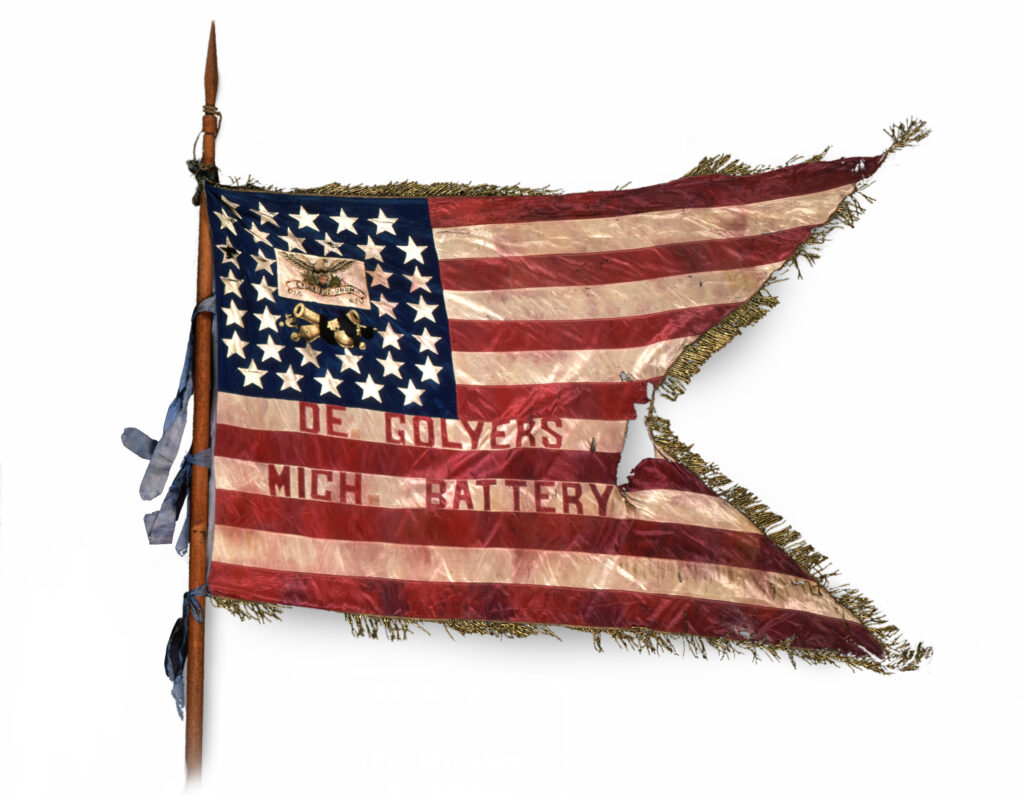
(Save the Flags, Michigan State Capitol)
Four days later, Grant’s columns inched closer to the defenses at Vicksburg. On a bald rise, Confederate forces set out to strike at Grant before he could hit them. The collision at Champion Hill was some of the most savage combat of the Vicksburg Campaign. Stubborn Confederate resistance and constant counterattacks during the early morning of May 16 stifled cohesion between attacking Union forces. At 9 a.m., the situation looked bleak for Grant, but fortune smiled on him as his wild card surged onto the battlefield.
DeGolyer unlimbered behind a rail fence just as another Confederate push threatened to beat back the Union advance for good. Using his keen gunner’s eye, DeGolyer noticed a better position and, according to an unnamed New York World correspondent observing the fight, “made a wide detour to the right…and opened a terrible enfilading fire upon the enemy.” The Confederate pressure subsided, but they came on again in typical fashion. The veteran Alabamians charged pell-mell into the mouths of DeGolyer’s guns. The horrified correspondent looked on as the Alabamians “advanced in solid columns and in magnificent style.” True to his command philosophy, DeGolyer waited “till they had reached a point two hundred yards from the mouth of the cannon…and discharged them, a terrible volley, full in the faces of the advancing columns.” Noticing a more proper undulation for his guns, DeGolyer fell back a short distance to the higher ground and behind a rail fence.
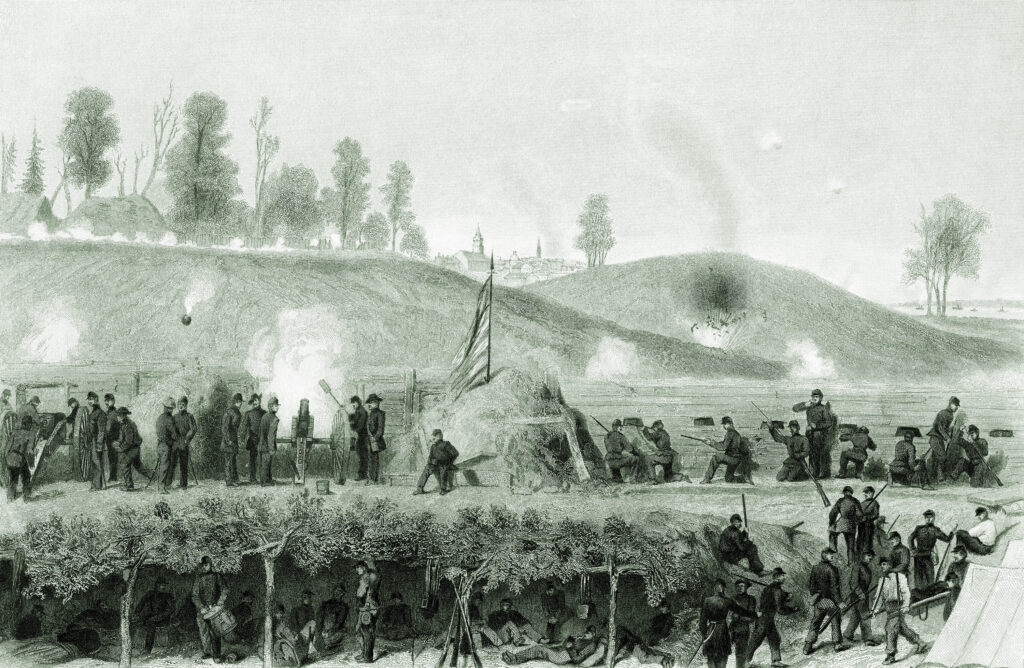
(Buyenlarge (Getty Images))
Sure enough, the Alabamians regrouped “as if by magic” and surged out of the tree line. A rail fence—DeGolyer’s first position—hindered the Confederate advance. The Michiganders waited for the exhausted Confederates to climb or pull down the rails and then unleashed a fierce cannonade that shredded the mob. In awe of the carnage, the New York World observer summed up the destruction: “It is impossible to convey an adequate idea of the slaughter occasioned on the right and centre of the line. The ground was literally covered with the dead and dying. In the ravines, behind trees, on the summit of the hills, lay the unfortunate men of both armies, some of them stiff and cold in death’s icy grasp, others with wounds of every description; here, an arm cut off by cannon balls; there a leg hanging on by the muscles.”
Indeed, DeGolyer and his elite unit were indispensable to Grant. A few weeks later, the Union Army approached Vicksburg and unleashed a series of bloody attacks that failed miserably. Grant recoiled and settled in for a siege. At the center of his line, he placed Captain DeGolyer and entrusted him with a command of 22 guns.
The Siege of Vicksburg lasted 47 days, but DeGolyer did not see the end. On May 28, the indispensable Captain Samuel DeGolyer was mortally wounded in the right leg and abdomen while resting in his tent behind his guns. Soon Sam’s wife, Catherine, rushed to his side and brought him home to Michigan, where he lingered for a few months before succumbing to his wound on August 8—just 33 years old.
Tour Stop One at Vicksburg National Military Park was christened “Battery DeGolyer” following the war, and his guns remain commanding the area to this day.
Trace Brusco is a Ph.D. student at the University of Alabama. There, he studies experiences in combat and community during the Civil War.

